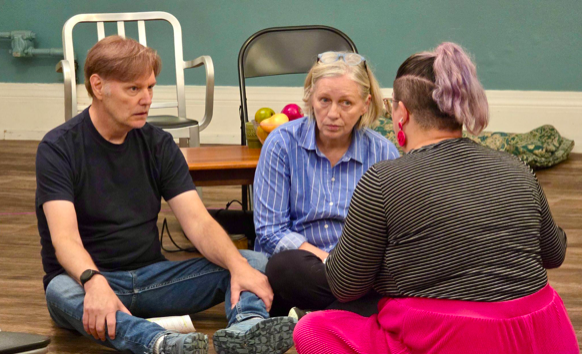INTERROGATING INTIMACY, BY JULIA FISHER
As an intimacy director, at least half of my job is asking questions. I have questions for actors; for directors; for costume, lighting, sound, and set designers. But my favorite questions (even when they can’t be answered directly) are for the playwright.
As a playwright myself, I know that every stage direction (at least in most scripts written since the ‘70s – but that’s a conversation for a separate blog post) has been just as carefully crafted by the playwright as any line of dialogue. So it is my job (and joy!) to analyze intimacy-related stage directions with as much love and vigor as an actor will analyze their lines.
One of my favorite literature professors (Dr. Chris Roark, who unfortunately passed away while I was a student at John Carroll University), told us repeatedly that what he wanted us to learn was not how to have the right answers – but how to ask the right questions. Our assignments involved typing out a scene or monologue (usually Shakespeare), then annotating every line, phrase, or word with as many questions as we could muster. We were not allowed to answer these questions; the interrogation was the exercise.
Let’s try this exercise together, using stage directions from The Children. Although I don’t generally type out my questions quite this formally, this interrogation is fundamental to my process of building intimacy.
The following stage direction describes a moment between Robin and Hazel:
He shakes his head.
She starts to cry.
He pulls her onto his lap or close to him.
He holds her.
Tender.
She clings to him.
He comforts her like a child.
Now let’s break it down line by line.
He shakes his head.
Do we want an actual head-shake here, or just the energy of “no”? What are the communication shortcuts that Robin and Hazel have built in their nearly-forty-year marriage? In what ways is this relationship comfortable/familiar/lived-in, and how can we communicate that beauty and efficiency to an audience?
She starts to cry.
What is the purpose of the line breaks between each of these stage directions? Noting that the playwright has said, “The text has been punctuated to serve the music of the play, not grammatical convention,” and recognizing that many stage directions elsewhere in the script do not have line breaks, what do these line breaks tell about the rhythm of this scene? How long should each of these beats take?
He pulls her onto his lap or close to him.
How could our stage picture capture the weight of this moment for these characters? Is there an area of the stage that we could activate in a new and unexpected way – perhaps the floor? If so, how could we arrive at this stage picture authentically, and what kind of support is needed from floor or furniture to ensure actor comfort?
He holds her.
What kind of holding position will allow Hazel to bury herself in Robin, while also not blocking either of their faces or bodies from the audience for too long? What holds would work for the actors’ bodies?
(This is where I might doodle a variety of potential holding positions.)
Tender.
How is this tenderness expressed - in energy? Touch? Proximity? Pressure? How does this mirror (or contrast) other moments throughout the piece? How does tenderness impact each character’s ability to feel the depths of their fears and griefs, and to be brave in the face of them?
She clings to him.
What exactly is Hazel clinging to? What feels like it’s slipping away? Is Robin trying to hold onto that thing with her, or soothe her while the thing slips away?
He comforts her like a child.
What is the significance of this line invoking the title of the play? How is Hazel behaving like a child? How is Robin behaving like an adult? How is this a continuation of or reversal of their behaviors thus far? What is beautiful and what is problematic about behaving like a child?
After compiling all these questions, I bring them into rehearsal, where we discover just as many new questions as we find answers. Although Lucy Kirkwood isn’t going to pop into rehearsal to answer any of these questions directly (a girl can dream), I believe that through interrogating her stage directions with care and curiosity, we can continue to unearth the core truth of the text.



